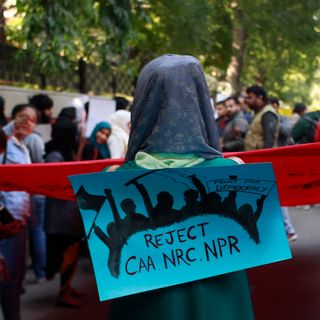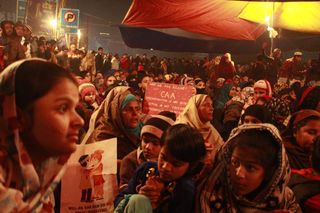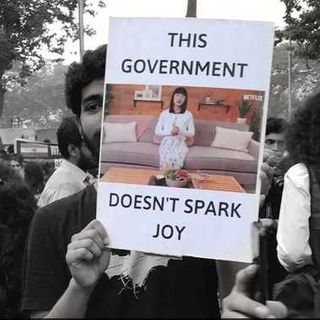
In Shaheen Bagh, Muslim Women Redefine Carework as Resistance
“It’s okay if I don’t see my children for a while; right now, I’m doing more important things for their future.”

On a silent, empty street in Delhi, straddling the boundary between the capital and its suburb of Noida, past numerous police barricades and amid small, winding alleys, lies a phenomenon never before seen in Indian society. Within an almost impenetrable wall of men, thousands of Muslim women, some as old as 82, sit underneath a makeshift tent, often with their children cradled in their laps, one eye on a wandering toddler and the other toward a stage on which activists deliver battle cries of the impending revolution. They sit in protest, most of them seven days a week, 24 hours a day, because the BJP-led government has compelled them to sleep on the streets, they say; because there’s nothing else left to do, they lament; because their children need them and because they’d rather die than be anywhere else, they proclaim. This is Shaheen Bagh.
It all began on Dec. 15, 2019, when the Delhi police broke into Jamia Millia Islamia university in Delhi and brutally assaulted the Muslim students peacefully protesting the National Register of Citizens (NRC) and the Citizenship Amendment Act (CAA). Reports of the police abusing the students (even non-protesters silently studying in a library), using communal language and beating students to the point of broken limbs, enraged student populations across India, who took to the streets immediately — their might demonstrated, loud and clear, that if law enforcement dared to repeat the barbarity in Jamia, crores more students would erupt in dissent. The night of the 15th, however, four women and six men — parents who were witnesses to the violence perpetrated by the police inside Jamia — returned to their neighborhood, lit a bonfire, and settled down on the street connecting Delhi to Noida, with no intention of getting up any time soon. What started with a handful of people appalled by the violence they saw being inflicted upon their children, has now become the nationwide symbol of resilience — Shaheen Bagh.
“We aren’t insane, you know, but the government has driven us here.”
“We are housewives,” says one of the first Shaheen Bagh women, Tarannum Begum, 45, whose children are Jamia students. “Before this, we cooked rotis at home and took care of our children. But today, we’re here to fight for the rights of our children, the rights of our families, and for the rights of fellow women sitting here.” In Shaheen Bagh, Begum says, nobody’s a leader and nobody’s a politician. “We went alley to alley, chanting ‘Apne gharo se bahar niklo; Abhi nahi to kabhi nahi’ (Come out of your homes; if not now, then never) and people responded. They came out in hundreds, then thousands, bearing food, water, tea, medical supplies — you can see the revolution that it has become today,” Begum adds, scanning the crowd in pride, constantly looking for protesters and guests who might need to be taken care of.
In Shaheen Bagh, the women’s full-time job — carework — has taken the shape of a revolution. The care they show toward their children has now been extended to their fellow women protesters; the love they show toward their families now spills out for their country in the songs they sing throughout the night; their unpaid labor has transcended the confines of their homes into the expanse of the street. Most of the women in Shaheen Bagh have never stayed out of their homes, away from their families, and especially their children, for this long before — 22 days since its inception today. Shirking household responsibilities informed by culturally-embedded gender roles is not a liberty most of them could take — until it came down to their very existence in this country and the forces threatening it. The women in Shaheen Bagh have, to a great extent, redefined what a protest looks like today: while the men, making up the wall around these women, aggressively express their dissent in the periphery of the protest space, the women simply exist, often with their children, comfortable with the belief that their unrelenting, overwhelming, and unique presence contributes more than enough to this fight.
Related on The Swaddle:
How the NRC‑CAA Will Affect Women, Transgender People and People With Disabilities
The women of India have a unique quality — they can manage any situation, says a Shaheen Bagh organizer, Shabina, 49. In the beginning, a major question that popped up was: for how many days would the Shaheen Bagh protesters be able to leave work, home and hearth, and sit on the roads? “The women told the men: go to work, earn the bread and butter, we’ll carry the torch of protecting the Constitution; we’ll carry the burden of fighting for a just India,” Shabina says. “No doubt it’s insanely cold, but in light of the barbarity we have seen, this cold is not being felt. We don’t feel it because we are fighting for our kids.”
While the Jamia violence did create the impetus for the Shaheen Bagh women to lodge themselves on an otherwise busy street, what’s keeping them there are two demands: repeal the CAA, which only allows non-Muslim minorities from neighboring countries of Afghanistan, Bangladesh, and Pakistan to be eligible for citizenship, and repeal the NRC, which, if expanded from implementation in Assam to be imposed nationwide, would require Indians to provide documents such as birth certificates, property ownership documents, educational certificates, and the like to prove they are citizens of India. Combine both, and any Muslim stripped of citizenship by not being able to provide their documents under the NRC will also not be able to appeal and regain their citizenship under the CAA.
“It’s not just the fight for Muslims; it’s a fight for the entire India. There are so many people, just in Shaheen Bagh, who don’t have their documents. We have grown up here, our ancestors have grown up here. How dare they threaten to ask us to prove our citizenship?” Saima Khan, 33, says. “After Jamia, there’s no more fear in our hearts. There’s no future for our children now; our lives are meaningless, except for Shaheen Bagh. We aren’t insane, you know, but the government has driven us here.”
“It’s okay if I don’t see my children for a while; right now, I’m doing more important things for their future.”
Khan is one of the several women who takes care of operations at Shaheen Bagh. She coordinates with journalists; she helps the older protesters give a press conference; she helps handle the speakers and singers on a wooden stage adorned with several Indian flags and a DIY sound system, sometimes having to announce the names of children separated from their parents — all the while walking around asking the women if they need water, and finally, lamenting she could not feed me dinner before I had to leave for the night. “We’re taking care of each other; we’re taking care of each other’s children — but most days, we ourselves are not being able to sleep, or eat, properly. Our entire lives are disturbed and we haven’t been able to do anything but this,” she says, adding she has four children she doesn’t bring to Shaheen Bagh, whom she leaves at home to fend for themselves while she’s at the protest site helping others.
Khan’s husband is usually out attending other protests around Delhi. She has a maid, so she can leave her children at home, which she says is still difficult. Others, like Munni Rafiq, 25, don’t have the option of leaving their kids at home — so Rafiq brings all six of them, and her husband, to the protest, every day. “I didn’t make the decision to come here; the government made it for me,” Rafiq said. “My husband left his work to be here. Everyone is taking care of me and my kids. If the entire neighborhood is here, why on earth would I stay home?”
The ever-present threat of violence from the police, however, does serve as a deterrent for some, such as Israt, 26, mother of three young boys. On her 19th day of protest at Shaheen Bagh, Israt says her family was incredibly supportive of her decision to commit to the sit-in. Her husband, brother-in-law, father, and all other male relatives offered to take care of the children in shifts, while also attending their fair share of protests at Jamia. “It was difficult for me to take the decision to step out and come here. But our children will only be well if we can ensure their future in a country in which the Constitution is not under threat. It’s okay if I don’t see my children for a while; right now, I’m doing more important things for their future.”
Related on The Swaddle:
How Anti-NRC-CAA Humor Can Work as a Tool of Political Resistance
And this valiant effort is being recognized, not just by the protesters and media throughout the country, but by the police, too. Khan says many goons have masqueraded as protesters inside Shaheen Bagh and attempted to break up the sit-in by frightening the protesters. On Jan. 5, 2020, when goons, allegedly from the Rashtriya Swayamsevak Sangh’s student body, Akhil Bharatiya Vidyarthi Parishad, beat up Jawaharlal Nehru University students, journalists reported the main purpose of the violence was to divert attention from the police’s efforts to obtain permission to break up the Shaheen Bagh protest. While on the inside, Shaheen Bagh is peaceful — women are seen chasing down their children at mealtimes, cradling them in their laps, coaxing them to fall asleep, helping distribute food to fellow protesters, and singing along with all the guest speakers and performers — on the outside, their sheer persistence and determination has uplifted the anti-NRC-CAA protest movement and shaken those seeking to dilute the dissent. In the coming days, activists fear Shaheen Bagh is about to become the sole target of Delhi police who fear its influence growing, but for the women inside, none of it matters. “I simply sit here. If that makes them want to kill me, let them. Let them do whatever they want. I’m not budging an inch,” Nafeesa Khatun, 45, says, in defiance.
Khatun, who has been at Shaheen Bagh for 22 days, and says she has only gone home thrice in that time, is sitting for all the women who cannot spend 24/7 at the protest — those who don’t have the luxury of domestic help, a supportive family, or simply the liberty of not taking care of a household. Enter single women, older women, widowed women, and women who can bring their entire families to the protest — between serving dinner and yelling “Inquilab zindabad” (Long live the revolution!) night in and night out, they have transformed from caretakers, volunteers, and friends, to revolutionaries.
“It’s a moment now; it’s not just a protest,” Shabina says. “Muslim women cannot step out of their houses without their husbands’ support, that is true — we need the support, but what’s more, we’re getting it. Gender cannot be a matter here because today, we are not simply sisters, wives, daughters, mothers — we are Indians. We are fighters.”
Rajvi Desai is The Swaddle's Culture Editor. After graduating from NYU as a Journalism and Politics major, she covered breaking news and politics in New York City, and dabbled in design and entertainment journalism. Back in the homeland, she's interested in tackling beauty, sports, politics and human rights in her gender-focused writing, while also co-managing The Swaddle Team's podcast, Respectfully Disagree.
Related


79‑Year‑Old Woman Elected Village Panchayat Chief After Door‑to‑Door Campaign
